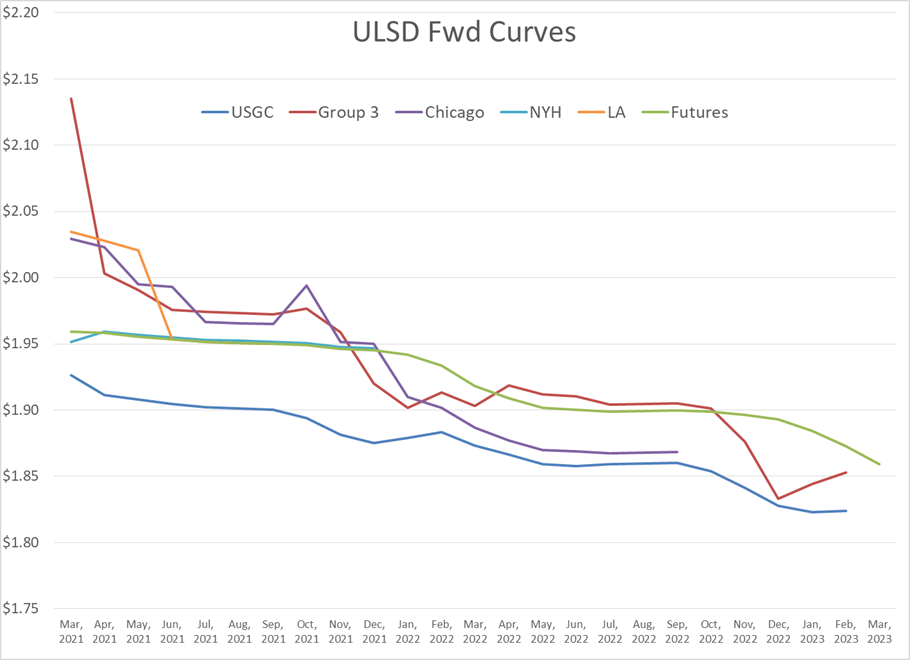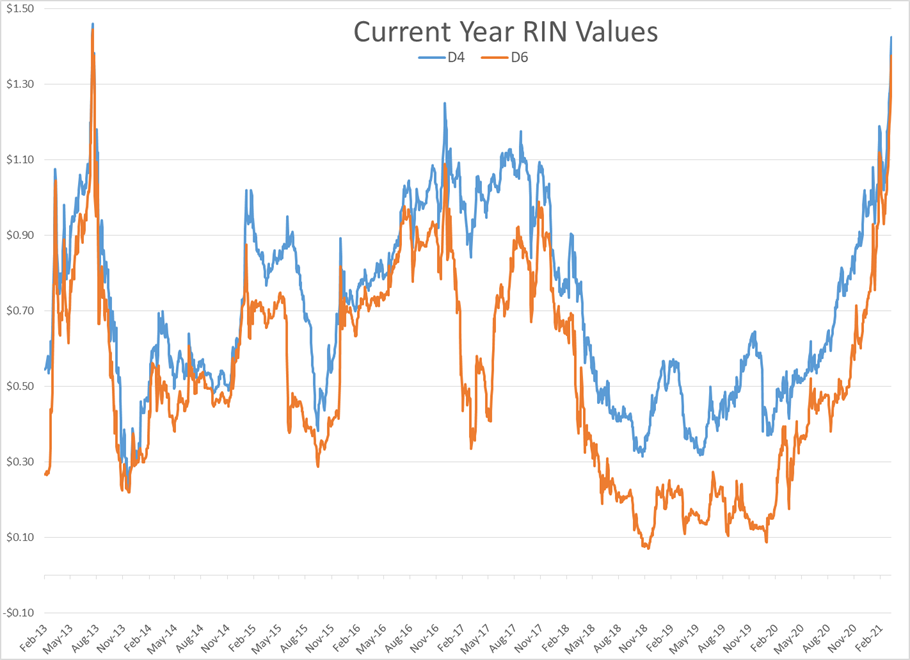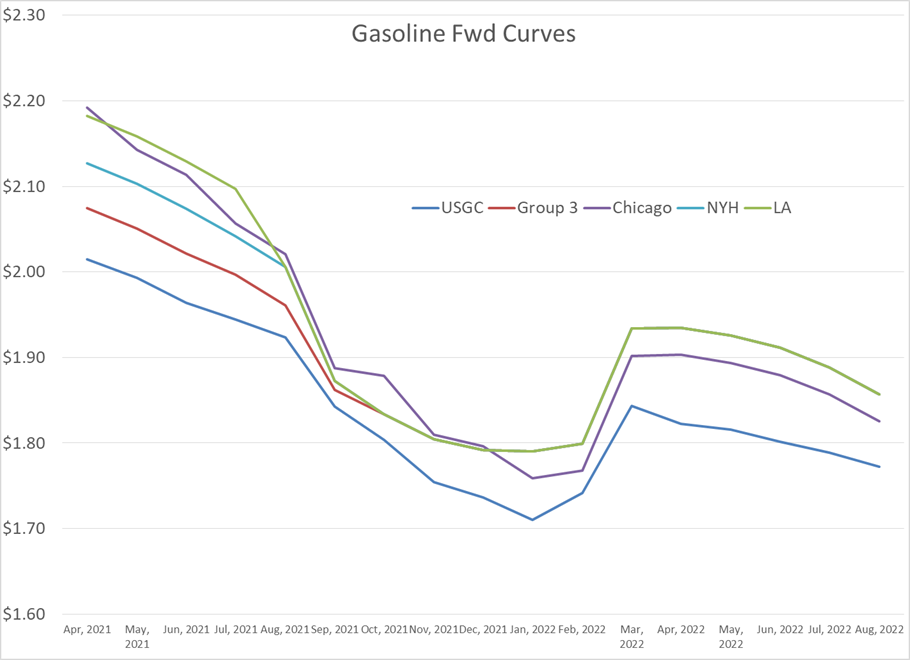Hope Has Never Been Higher In The History Of The RBOB Market

A year ago today gasoline prices dropped from $1.10/gallon to $.85, as traders awoke to the reality that the country was about to be placed on lockdown. What a year it’s been.
If you only watched futures prices, you’d think the country was facing a severe gasoline shortage now as RBOB prices have spiked to a 2 year high this week, even though in reality it’s diesel supply that’s facing shortages across large parts of the US. We are in the window of the typical spring gasoline rally however, and it’s safe to say hope has never been higher in the history of the RBOB market as the vaccines are finally shining a light at the end of the COVID tunnel.
On top of the seasonal and emotional influences, RIN markets seem to be having a noticeable influence on pricing, as product prices need to move higher just to offset the increased cost of compliance with the RFS for refiners. RIN values are approaching their all-time highs this week with trades just a few cents away from the record spike we saw in 2013. As the chart below shows, not long after trading near the $1.50 mark in 2013, prices plummeted by more than $1.20 per RIN as the EPA finally acknowledged the blend wall that made the RFS mandates physically impossible to reach. Will it be different this time around? That will likely depend on how the supreme court rules this summer on refinery & environmental waiver requests.
Double Top? As of this writing, the high trade for RBOB is $2.1559, which matches the high trade from April of 2019 to the point, and could create a nice symmetric stopping point for the 4.5 month old rally that’s added nearly $1.20 to gasoline prices. If that plays out, we should see gasoline prices drop 30 cents or more, for no other reason than that’s what they normally do each year whenever the spring rally finally stalls out. That said, there’s a good chance based on the upward momentum that we see prices move through that resistance, which would open the door for a run at the 2018 highs in the $2.28 range.
The refinery recovery continues with improvements coming daily, but still more outages expected over the next week as the system refills. Basis values and rack spreads are returning to more normal levels as the consensus from physical traders is that the worst of the disruption is behind us and it’s just a matter of time until things settle down. Colonial pipeline is reportedly still slowing its line 2 due to limited diesel supplies, and maintenance activities, which will keep terminals all along the SE tight for at least another week.
Drama in index land? Planned changes to add WTI pricing to the Brent oil index have been delayed after the industry rejected the plan. Given the long history of the parent company’s ability to make huge sums of money for index subscriptions, whether or not they’re grounded in reality, there’s little doubt that a new plan will be launched soon.
Click here to download a PDF of today’s TACenergy Market Talk.
Latest Posts
Crude Oil Inventories Climbed Above Year-Ago Levels For The First Time In 2024
Week 17 - US DOE Inventory Recap
The Energy Complex Is Trading Modestly Lower So Far This Morning With WTI Crude Oil Futures Leading The Way
Energy Futures Are Drifting Quietly Higher This Morning
Social Media
News & Views
View All
Crude Oil Inventories Climbed Above Year-Ago Levels For The First Time In 2024
Sell by May then go away.
The old trading adage looked good for energy markets in 2024 as the new month started off with the biggest daily sell-off of the year so far. WTI and ULSD contracts are now in “rally or else” mode on the charts with sharply lower prices a strong possibility now that technical support layers have broken down. RBOB doesn’t look quite as bearish on the charts, but seasonal factors will now act as a headwind as we’re well into the spring peaking window for gasoline prices, and we’ve already seen a 27 cent drop from the highs. If RBOB can hold above $2.50 there’s a chance to avoid a larger selloff, but if not, a run towards $2.20 for both gasoline and diesel looks likely in the months ahead.
The selling picked up steam following the DOE’s weekly report Wednesday, even though the inventory changes were fairly small. Crude oil inventories continue their steady build and climbed above year-ago levels for the first time in 2024. Demand for refined products remains sluggish, even after accounting for the RD consumption that’s still not in the weekly reports, and most PADDs are following a typical seasonal inventory trend. The Gulf Coast saw a healthy build in diesel inventories last week as the export market slowed for a 3rd straight week. Refinery runs dipped modestly last week following a handful of upsets across the country, but overall rates remain near normal levels for this time of year.
The Transmountain pipeline expansion began operations yesterday, completing a 12-year saga that has the potential to materially change refining economics for plants in the US that relied heavily on discounted Canadian crude to turn profits over the past decade.
The P66 Borger refinery reported another operational upset Monday that lasted a full 24 hours impacting a sulfur recovery unit. Last week the company highlighted how the plant’s fire department helped the surrounding area when the largest wildfire in state history came within feet of the facility.
The EPA approved a new model to determine life cycle carbon intensity scores this week, which cracks open the door for things like ethanol to SAF, which were previously deemed to not reduce emissions enough to qualify for government subsidies. The new model would require improved farming techniques like no-till, cover crop planting and using higher efficiency nitrogen fertilizer to limit the damage done by farms that no longer rotate crops due to the ethanol mandates. Whether or not the theoretical ability to produce SAF comes to fruition in the coming years thanks to the increased tax credit potential will be a key pivot point for some markets that find themselves with too much RD today, but could see those supplies transition to aviation demand.
The FED continues to throw cold water on anyone hoping for a near term cut in interest rates. The FOMC held rates steady as expected Wednesday, but also highlighted the struggles with stubbornly high inflation. The CME’s Fedwatch tool gave 58% odds of at least one rate cut by September before the announcement, and those odds have slipped modestly to 54% this morning.

Week 17 - US DOE Inventory Recap

The Energy Complex Is Trading Modestly Lower So Far This Morning With WTI Crude Oil Futures Leading The Way
The energy complex is trading modestly lower so far this morning with WTI crude oil futures leading the way, exchanging hands $1.50 per barrel lower (-1.9%) than Tuesday’s settlement price. Gasoline and diesel futures are following suit, dropping .0390 and .0280 per gallon, respectively.
A surprise crude oil build (one that doesn’t include any changes to the SPR) as reported by the American Petroleum Institute late Tuesday is taking credit for the bearish trading seen this morning. The Institute estimated an increase in crude inventories of ~5 million barrels and drop in both refined product stocks of 1.5-2.2 million barrels for the week ending April 26. The Department of Energy’s official report is due out at it’s regular time (9:30 CDT) this morning.
The Senate Budget Committee is scheduled to hold a hearing at 9:00 AM EST this morning regarding a years-long probe into climate change messaging from big oil companies. Following a 3-year investigation, Senate and House Democrats released their final report yesterday alleging major oil companies have internally recognized the impacts of fossil fuels on the climate since as far back as the 1960s, while privately lobbying against climate legislation and publicly presenting a narrative that undermines a connection between the two. Whether this will have a tangible effect on policy or is just the latest announcement in an election-yeardeluge is yet to be seen.
Speaking of deluge, another drone attack was launched against Russian infrastructure earlier this morning, causing an explosion and subsequent fire at Rosneft’s Ryazan refinery. While likely a response to the five killed from Russian missile strikes in Odesa and Kharkiv, Kyiv has yet to officially claim responsibility for the attack that successfully struck state infrastructure just 130 miles from Moscow.
The crude oil bears are on a tear this past week, blowing past WTI’s 5 and 10 day moving averages on Monday and opening below it’s 50-day MA this morning. The $80 level is likely a key resistance level, below which the path is open for the American oil benchmark to drop to the $75 level in short order.
Click here to download a PDF of today's TACenergy Market Talk.



